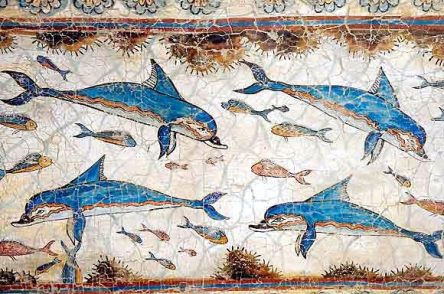
There are several species of dolphin inhabiting the waters of the Mediterranean and for the seafaring people of Ancient Greece there were bound to have been numerous encounters with these playful, inquisitive, and intelligent sea mammals. It’s apparent that the Greeks took special delight in dolphins. In some areas, they were known as “philomousoi” or, “music lovers”, as it was commonly believed that dolphins loved music and would dance upon the water if they heard a good tune. Furthermore, we have numerous depictions of dolphins in a diverse array of art media: sculpture, pottery, frescoes, tile work, and even on the face of coins. And of course, dolphins figure in various Greek myths. So, it is little wonder that the Greeks decided to honor the dolphin by placing one in our northern hemisphere sky. If you know when and where to look, you too can see this celestial cetacean swimming just to the eastern side of the Milky Way.
WHEN AND WHERE TO LOOK
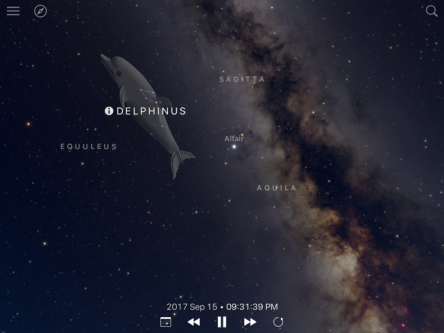
The constellation of Delphinus (pronounced: del-fine-us), which is the Greek word for “dolphin”, can be found on September evenings by going outside at around 9:00 PM or 10:00 P.M. and facing due south. Now, look almost directly overhead for the three brightest stars in this area of the sky. We are looking for a rather large asterism (an unofficial pattern of stars made up from the stars of one or more of the officially recognized constellations) known as, the Summer Triangle. The very brightest star overhead is Vega, in the constellation of Lyra, the Harp. Once you have found Vega, extend an imaginary line to the left (east), for about 2 ½ fist widths held out at arm’s length, until you come to the next star that is comparable in brightness (but just a bit dimmer) to Vega. This star is called Deneb, and it is the tail end of Cygnus, the Swan. To complete the triangle, go back to Vega and extend a line almost straight down until you come to the next brightest star, Altair, in Aquila, the Eagle.
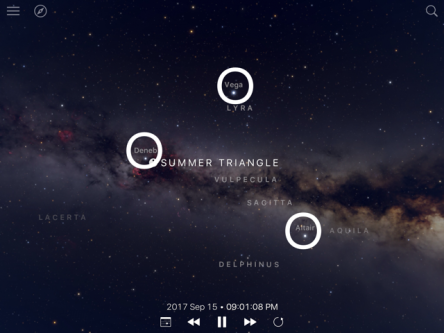 Delphinus is to the immediate left (east) of Altair and just a little bit above it (about one fist width away). The Milky Way extends through Deneb and back down to the west of Altair, Delphinus appears to be swimming along the eastern side of the Milky Way. The body of the dolphin is formed out of four dim stars, right around 4th or 5th magnitude, that form a pattern resembling an elongated diamond. This diamond pattern is itself an asterism known as “Job’s Coffin”. The tail of the dolphin is denoted by a sixth star, shining at around 4th magnitude, just off to the SW of the diamond. Its name is Deneb al Dulfim, an Arabic phrase meaning, “the dolphin’s tail”.
Delphinus is to the immediate left (east) of Altair and just a little bit above it (about one fist width away). The Milky Way extends through Deneb and back down to the west of Altair, Delphinus appears to be swimming along the eastern side of the Milky Way. The body of the dolphin is formed out of four dim stars, right around 4th or 5th magnitude, that form a pattern resembling an elongated diamond. This diamond pattern is itself an asterism known as “Job’s Coffin”. The tail of the dolphin is denoted by a sixth star, shining at around 4th magnitude, just off to the SW of the diamond. Its name is Deneb al Dulfim, an Arabic phrase meaning, “the dolphin’s tail”.
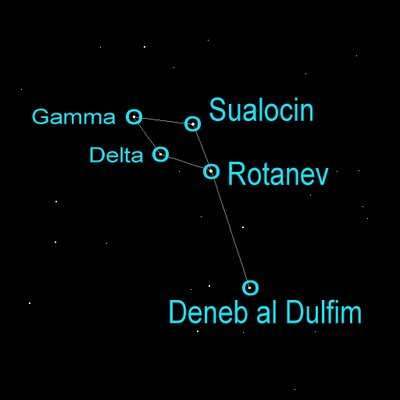
Because the five stars that make up the outline of Delphinus are so dim, it is recommended that you try and find the constellation on dark, moonless nights from a moderately dark-sky area.
MYTHOLOGY
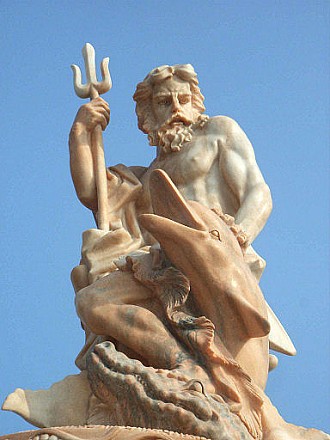
In one version of the Delphinus myth, the god Poseidon, a bachelor for many years, decided to go a-courting. The object of his infatuation was a Nereid (a sea nymph) named Amphitrite. Unfortunately for Poseidon, Amphitrite did not reciprocate his feelings and the sea god’s heart was crushed. Not being one to give up hope, Poseidon sent a dolphin to act as a messenger to Amphitrite and, before long, the sea nymph gave in and decided to go out on a few dates with the god of the sea. It was only a matter of time before the two kids got married and an eternally grateful Poseidon gave the dolphin a place of honor in the sky for helping bring about the union.
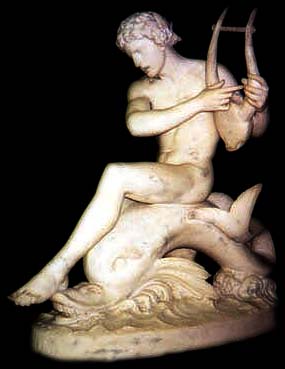 Another tale involves the real-life poet and musician named Arion, from the 7th century BC. According to the story, Arion, who hailed from the island of Lesbos, had a reputation as quite the crooner throughout the Mediterranean region and his voice and talent with the lyre made him a much sought after entertainer. After one of his concert tours, Arion, laden with a fortune from all his ticket sales, decided to head home for a much-needed rest. Unfortunately, he hitched a ride on a ship filled with cutthroats who coveted his boxes of money. Biding their time, they waited until the boat was out at sea before making their move. Arion soon found himself cornered by pirates who were ready to toss him over the side of the boat. Seeing that the end was near, Arion asked the villains if he could play just one more tune upon his lyre. I guess these were somewhat honorable pirates because they decided to grant him his request. Arion strummed the musical instrument and the sound was so beautiful that a dozen or more dolphins surrounded the boat and began to dance upon the water.
Another tale involves the real-life poet and musician named Arion, from the 7th century BC. According to the story, Arion, who hailed from the island of Lesbos, had a reputation as quite the crooner throughout the Mediterranean region and his voice and talent with the lyre made him a much sought after entertainer. After one of his concert tours, Arion, laden with a fortune from all his ticket sales, decided to head home for a much-needed rest. Unfortunately, he hitched a ride on a ship filled with cutthroats who coveted his boxes of money. Biding their time, they waited until the boat was out at sea before making their move. Arion soon found himself cornered by pirates who were ready to toss him over the side of the boat. Seeing that the end was near, Arion asked the villains if he could play just one more tune upon his lyre. I guess these were somewhat honorable pirates because they decided to grant him his request. Arion strummed the musical instrument and the sound was so beautiful that a dozen or more dolphins surrounded the boat and began to dance upon the water.
The somewhat honorable pirates also happened to be a very superstitious lot and they began to get a bit nervous with all these dolphins dancing around in the water. Arion, a smart lad who knew a good thing when he saw it, leapt overboard, thinking that the dolphins must be some kind of sign from the gods themselves. Turns out he was right. Apollo, who, amongst other things, happened to be the god of music and poetry, sent the dolphins to rescue poor Arion. Before he knew it, Arion was upon the back of one of the dolphins, who proceeded to carry him safely to shore. Justice was served as Arion was able to notify the authorities, who arrested the pirate gang as soon as they docked. Apollo was so pleased with the dolphin rescue that he placed the heroic creature upon the sky for all to see. In addition to the dolphin, Apollo also placed Arion’s lyre in the sky and, so, (according to this legend) this is how we also got the nearby constellation of Lyra, the Harp.
CONSTELLATION FACTS
- Out of all the 88 constellations, Delphinus comes in at number 69 in terms of the total area it covers upon the sky: 169 square degrees. By comparison, Ursa Major, the Big Bear, occupies a total of 1,280 square degrees upon the sky.
- Delphinus is one of the original 48 Greek constellations cataloged by 2nd century astronomer, Ptolemy, in his famous book, “The Almagest”.
 The names of Delphinus’ alpha and beta stars are (respectively): Sualocin and Rotanev. They appeared for the first time in a star catalog published in 1814 by the Palermo Observatory in Italy. No one had ever heard of these two stars before. Where did they come from? It turns out that they were given these names by one Niccolo Cacciatore, an assistant astronomer at the observatory. If you translate his name into English, you get “Nicholas Hunter”. If you Latinize this name, you get “Nicolaus Venator”. If you spell this backwards, you get “Sualocin” and “Rotanev”. It seems that Niccolo was a bit of a cheeky devil.
The names of Delphinus’ alpha and beta stars are (respectively): Sualocin and Rotanev. They appeared for the first time in a star catalog published in 1814 by the Palermo Observatory in Italy. No one had ever heard of these two stars before. Where did they come from? It turns out that they were given these names by one Niccolo Cacciatore, an assistant astronomer at the observatory. If you translate his name into English, you get “Nicholas Hunter”. If you Latinize this name, you get “Nicolaus Venator”. If you spell this backwards, you get “Sualocin” and “Rotanev”. It seems that Niccolo was a bit of a cheeky devil. 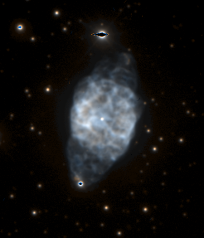
- Gamma Delphini, the easternmost star in the Job’s Coffin asterism is a lovely double star located about 101 light years away. A small backyard telescope can split them for you. The primary star is a yellowish color, while the companion is a blue-green. Astronomers think that it takes about 3200 years for the pair to orbit around one another.
- Delphinus doesn’t contain many deep-sky objects but one in particular is accessible with a 4 inch backyard telescope (although it will show up better with larger apertures): NGC 6905, better known as, the “Blue Flash Nebula”. It was discovered in 1784 by famed English astronomer, Sir William Herschel. The small, blue blob that you will see is the corpse of a dead, sun-like star. After having expended all of its fusible material, the core of the star contracted, became very hot, and then blew away its outer layers in a shell of gas and dust. The radiation from the now exposed white-hot core is making the gas shells fluoresce, much like a neon sign, and so it glows in this ghostly, bluish light.